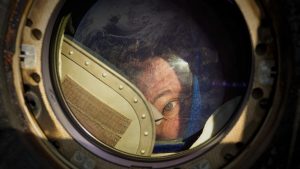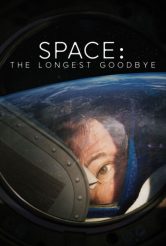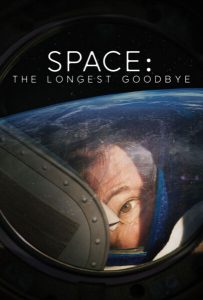
Expedition 27 Flight Engineer Cady Coleman peeks out of a window of the Soyuz TMA-20 spacecraft shortly after she and Commander Dmitry Kondratyev and Flight Engineer Paolo Nespoli landed southeast of the town of Zhezkazgan, Kazakhstan in SPACE: THE LONGEST GOODBYE | © 2024 PBS
SPACE: THE LONGEST GOODBYE premieres on PBS’s INDEPENDENT LENS on Monday, May 6, and is now available to stream on the PBS app and on PBS’s YouTube channel. Directed by Ido Mizrahy, the documentary examines the effects of long space missions on both the astronauts and the families they leave at home. Mizrahy’s previous projects include the narrative feature THINGS THAT HANG FROM TREES and the documentary GORED.
During PBS’s portion of the Winter 2024 Television Critics Association (TCA) press tour in Pasadena, SPACE: THE LONGEST GOODBYE director Mizrahi, chemist and former NASA astronaut Catherine Grace “Cady” Coleman, who was a member of the crews for the missions STS-73, STS-93, and the International Space Station Expedition 26, and Coleman’s now twenty-three-year-old son Jamey Simpson sit down together to talk with ASSIGNMENT X about the film.
Mizrahy relates that his documentary about NASA began with different subject matter. “Initially, we went to the various NASA centers, thinking we were going to do something about the mission to Mars. It was very general. We just liked the idea of that whole canvas, and we met astronauts, and we met flight directors, and we met engineers. We met a lot of different people in Alabama, in Huntsville, at Kennedy.
“And then, there was a meeting that they had scheduled with a space psychologist at Johnson Space Center, Dr. Al Holland. I had never even considered that there was a department that would deal with those things. I’ve got to say, until that moment, I thought, it’s funny to say, ‘I don’t have a movie. I’m meeting all these people, it’s super-interesting, but there are way better directors to go and make a great science documentary about the mission to Mars, and pick apart something about the engineering, or something about the inspiring stories of going to space. It’s not me.’ After I met Al Holland, I thought, ‘Oh, okay. Here’s a story about loneliness and isolation and separation that could be told in this world of space travel that we could really pursue, and it would be a very different story.’ I’ve always been really interested in psychology and psychoanalysis, so it was nice to finally jump in.
“Once we started doing that, the thesis of what I wanted to say about that evolved. It evolved also because of COVID. It’s funny to say, but we started this, we thought, ‘Oh, isolation, that’s a very topical thing’,” Mizrahy laughs. “This is before COVID. And then, suddenly COVID hits, and everybody’s thinking, ‘Oh, this is what it feels like to be isolated from your social support. This is what it feels like to communicate remotely.’ And also, surprisingly, yes, we were looking forward to reconnecting with people again, but is there also something scary about coming back to society? Is there something scary about opening those doors and reconnecting with people? And so, I think those ideas came later and really affected the editing, if they didn’t affect the filming.”
What does documenting space exploration do for Mizrahy?
“It was probably, unfortunately, the closest I’ll get to space, although that dream is still alive,” says Mizrahy, “but it felt [like] any story I could tell that takes place in space satisfied an intense desire to be there, to go that far, to experience all those very different sensual sensations. It’s weird, but for the first time to feel what it’s like to be that far away, and what it means to leave everything you know behind for a moment, and feel that tension between where you want to go in achieving those dreams, and at the same time, maintaining those roots.”
Mizrahy continues, “This is kind of a departure from the arena that the movie takes place in, which is space. It’s a huge metaphor, and a story about accomplishing dreams and still finding ways to be connected to your roots, which I think is something that many of us have experienced in different ways. Even just having moved away from home to go to school or to do something, and then finding that tension that you can’t be two places at the same time.”
What does Coleman get out of going into space?
Coleman replies, “I would say, it’s not about what it does for me, but it’s about what’s important that we do up there. At the same time, since I get to go, there’s nothing like being able to really understand that there are places that are further away that we can go, and that you’re on the very edge. If we’re leaving Earth and going further, you’re actually one of the six humans that are the furthest away right now. We’re still close to Earth in a way, but life up there without much gravity is so different.”
Within the spacecraft, “You get to fly everywhere. This floating idea – that’s from what happens in a capsule, because there’s not much room in it. Because there’s no gravity, everything’s going to float, but up there, we have a lot of room. It’s huge, like ten train cars without the seats in them, and we have to fly from place to place if we want to get anywhere. And so, what I get out of that is that it’s a magical place that’s at the edge of where everybody is, and I guess also just that view of the Earth. You still feel very close to Earth, but you look back in to see that everyone could be so very connected, and that they are, they just don’t know it.”
A perhaps trivial but compelling question: in SPACE: THE LONGEST GOODBYE, we see people sitting down inside the spacecraft, but their hair is floating around them. What is going on here?
Coleman explains, “It’s not possible to actually sit and stay in one place, unless your toes are keeping you there, or you’ve actually strapped yourself in. I came back with calluses on the top of my feet, because we have all these handrails you could grab with your hand, but you stick your foot under it and go up with your toes, and then that’s how you hold yourself in place.”
When Simpson is asked whether he had any veto power as a child over what his parents did, he and Coleman both laugh. “Not really,” Simpson says. “A lot of people say, ‘Oh, it must have been really hard to have your mom not going to your baseball games, or your band recital,’ but at the end of the day, what was instilled in me from a very young age was just the fact that the work that my mom is doing up on the Space Station, the sacrifices that she’s making, and the sacrifices that our family is making is for the betterment of all humankind, and that she is accomplishing a lot of work, and answering questions to challenges that are some of the most pressing in our world. So, for me to get frustrated and veto her going to space was really something that was completely out of the question. It was never something that I considered.”
Simpson adds that Coleman’s work has inspired him professionally. “I’m not an astronaut, but I think that something my mom has taught me is, just in terms of telling stories about whatever it is you’re doing, whether it’s profound or completely mundane, it’s really important to be able to bridge those two worlds together. I work as a photographer in Washington, D.C., and I think part of that is my way of documenting the world around me, and bridging my two worlds together.”
Coleman notes that the family had experience with physical separation even before she went into space. “My husband, Jamey’s father [glass artist Josh Simpson], and I had a commuting marriage for twenty-six years, mostly between Houston and western Massachusetts. There are a lot of parallels that land-based isolation has. And you don’t even have to be [far apart], you can just be isolated. I’ve been working on a book above my garage. I feel pretty isolated there, actually, because there’s just not time to check in with people, or be in touch, and even sometimes get the hug you need,” she laughs, “before you go onto the next deadline. But we try to learn from those parallels.”
At one point, Coleman had a very long-distance land-based separation from her son and her husband. “I was sent to Antarctica for two-and-a-half months. Jamey was two. I was a last-minute replacement for someone. I got a phone call, and they said, ‘Are you still a volunteer?’ And I was like, ‘We need to make a decision as a family, I’ll call you back in five minutes, but you can think, yes.’
“And I talked to my husband – he was so excited. I finally said, ‘Sweetie, you realize I am not taking the baby with me.’ And I did not. That just seemed to work out okay. But we learned a lot. I learned a lot in Antarctica. I don’t think you have to go that far to learn a lot about yourself, and what kinds of needs, and things you might do well that might surprise you, and things you might do poorly that might surprise you – all things that it’s good for us to learn before we go to space.”
One of the things Coleman learned on the NASA missions – space itself is colder than Antarctica, but the accommodations are warmer. “It is way nicer on the space station. And I tell people, it is exactly whatever temperature the commander would like it to be,” she laughs, “which is usually pretty temperate, not too cold. In Antarctica, the thing I learned is, all those things that your parents told you growing up about dressing in layers, they are just true. Three of everything, three layers, and it works.”
Simpson adds, “I think there are a lot of parallels between my mom being in space and doing a training mission off in Russia or Japan, because for several months at a time before her mission, she would go off and train for long periods of time. So, I was, from a very young age, pretty well-versed in long-distance relationships like that. You learn to get into a routine with a time difference, when to say goodnight and when to say good morning, and a lot of the things that we learned when she was doing her missions abroad, we applied to her being in space as well.”
In SPACE: THE LONGEST GOODBYE, we hear an astronaut giving his thoughts. Mizrahy explains that this is courtesy of the work of Dr. Jack Stuster, who is one of the subjects of the documentary. “Dr. Stuster had done a number of different projects for NASA, and one of them was [asking] a number of astronauts if they’d be willing to write these very personal journal entries. It was the first time something like this had been done.”
Coleman says she had wanted to participate, but the timing did not work out. “[Dr. Stuster] promised to sanitize it, so to speak, so that it wasn’t clear who was saying it.”
Mizrahy continues, “A few of them agreed, and their names were taken out, and other details were redacted. He gave me the complete report, with all these quotes. We couldn’t bring back the astronaut to do it, but we had someone read it, and then we figured out the right shots for it.”
There are also sequences of an astronaut interacting with VR. Coleman explains, “What you saw was very early renditions of, how could we make this work, from the European Space Agency. That was actually after my mission.”
Astronauts are often trained with mission simulations on Earth. In SPACE: THE LONGEST GOODBYE, we see that one simulation was ended after eight days when someone got injured.
Mizrahy prefaces his comments with, “I always have to be careful how I tell this story, because there are many details I’m not supposed to mention. I’ll start with the end. Someone got hurt, but [the injury was] nothing lasting. And, like we say in the film, [the simulation ended not because of] the accident itself, it was the fact that the crew couldn’t then agree on whether they felt safe enough to stay. I think NASA said, ‘Well, if you could keep three out of the four in, we’ll continue the mission, and we’ll say it’s not contaminated, that it could continue as is, and we don’t need to reset it.’ But it ended up that two out of the four didn’t want to stay. And the other two couldn’t convince them, and so they had to [end] it.”
If this were a real space flight, Mizrahy points out, “The tricky part is, of course, when they’ll go to Mars, you don’t even have to go that far, you can go to the moon, or just far enough, you can’t just suddenly end the mission. It’s not that easily to suddenly send people back. So, that’s where those simulations end and the real space exploration begins.”
How does NASA determine whether individual astronauts will get along with each other within the confines of a spacecraft?
Mizrahy says that he started with preconceptions that turned out to be incorrect. “When I met Dr. Holland, I said, ‘Oh, you’re going to pick people who have no families or spouses or kids or anyone that they really need to separate from for a long time, and it’ll be easy. They’ll go, and they’re used to being alone, and it’ll be fine, and they’ll come back.’
“And he said, ‘Well, I could do that, but if people who don’t have somebody waiting for them to come back, will they make really smart decisions? Will they actually sustain this kind of long journey and make smart, thoughtful decisions if they have nothing major like that to lose? This is really big for us.’ This isn’t about group dynamics, this is more about the qualities for every specific individual.” He turns to Coleman. “Cady, how do you pick the right qualities that would work well together as a group?”
“Well, I don’t get to pick,” Coleman laughs. “Actually, another thing I think was in there was also that people who have relationships with a variety of other people here on Earth have had some practice figuring out what those relationships mean and where they themselves end and somebody else starts. So, I would agree with you about that.
“In terms of just picking teams for NASA, as far as I know, NASA or any other space agencies don’t have the luxury of saying, ‘This person and this person will get along great, why don’t we send them together?’ Because when you think about whose turn it is, and which country, and what other astronauts, and I’ll just speak for the U.S., who’s in what stage of development needs to fly a short mission now, so they’re ready for a long one later, it is very complicated and they work hard in the selection to pick people that are going to be professional, are going to always be on a course of continuous improvement, and willing to look at themselves, and they just do their best.”
What do the filmmaker and his subjects want viewers to get out of SPACE: THE LONGEST GOODBYE?
Mizrahy says, “I hope it’s a really special meeting place between an exciting space story, and the story of just what we need from each other, and what it means to handle that tension between our dreams and our homes and our loved ones.”
Simpson adds, “This film brings up a lot of questions about space travel, and how we can best go about that for longer missions. I think it’s going to take a lot of coming together, and bringing diverse people to the table with diverse sets of solutions to solve these problems.”
Coleman concludes, “In my experience, on any difficult project, whether it’s Earth-based or space-based, there can be the companies and the organizations that are all doing things up at a top level, but it’s actually the people coming together that are going to solve these hard problems together. And so, what I love about THE LONGEST GOODBYE is that it puts the ‘human’ into human space flight, because that’s the only way that we can go further.”
Follow us on Twitter at ASSIGNMENT X
Like us on Facebook at ASSIGNMENT X
Article Source: Assignment X
Article: Exclusive Interview: Space: The Longest Goodbye – Filmmaker Do Mizrah, Astronaut, Cady Coleman, Subject Jamey Simpson on new documentary
Related Posts:












